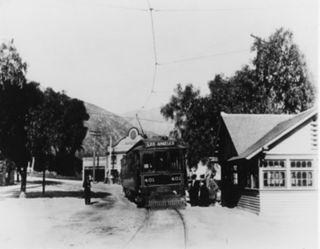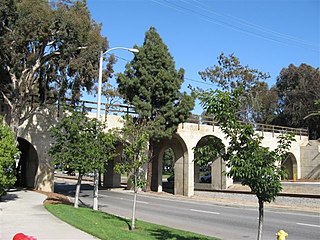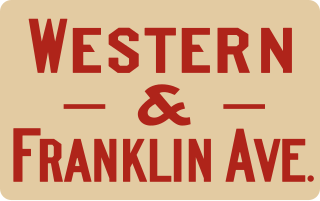
Venice Boulevard is a major east–west thoroughfare in Los Angeles, running from the ocean in the Venice district, past the I-10 intersection, into downtown Los Angeles. It was originally known as West 16th Street under the Los Angeles numbered street system.

The Monrovia–Glendora Line was a route on the Pacific Electric Railway serving the San Gabriel Valley. It operated from 1902 to 1951, supporting nearby real estate development.

Glendale–Burbank is a defunct Pacific Electric railway line that was operational from 1904 to 1955 in Southern California, running from Downtown Los Angeles to Burbank via Glendale. Short lines terminated Downtown and in North Glendale, including the popular Edendale Local.

The Sierra Madre Line was a Pacific Electric interurban route which ran 16.52 miles (26.59 km) from the Pacific Electric Building in Los Angeles to Sierra Madre.

The Pasadena Short Line was a passenger railway line of the Pacific Electric Railway. It ran between Downtown Los Angeles and Downtown Pasadena, California, through Eastside Los Angeles along the foot of the eastern San Rafael Hills to the western San Gabriel Valley. It was in service under the company between 1902 until 1951, though it had operated under different companies back to its beginnings as a horsecar line. The route, designated by the company as line 2, was the key component of the company's Northern Subdivision.

The Upland–San Bernardino Line was an interurban line operated by the Pacific Electric Railway between Downtown Los Angeles and San Bernardino, California. This line also had shorter service that terminated before the end of the line at Baldwin Park, Covina, and San Dimas. Though service along this line in its entirety was discontinued in November 1941, it stands as the fourth-longest rapid transit line in American history, after the Sacramento Northern Railway's Chico and Colusa services, and the Pacific Electric's own Riverside–Rialto Line.

The Balboa Line was the southernmost route of the Pacific Electric Railway. It ran between Downtown Los Angeles and the Balboa Peninsula in Orange County by way of North Long Beach, though the route was later cut back to the Newport Dock. It was designated as route 17.

The Owensmouth Line was a Pacific Electric interurban service that connected the San Fernando Valley to Downtown Los Angeles. The route was largely developed as the result of real estate speculation.

La Habra–Fullerton–Yorba Linda Line was a Pacific Electric interurban line which traveled between Los Angeles and Yorba Linda. Passenger services ran between 1911 and 1938. Initial plans were for the route to continue further east to form a second main line between Los Angeles and San Bernardino, though these would go unfulfilled. After passenger service ended, much of the route was retained for freight service, eventually becoming the Union Pacific La Habra Subdivision.

The Fullerton Line was an interurban route of the Pacific Electric Railway. It ran between Downtown Los Angeles and Fullerton, California. It opened in 1917 and hosted passenger service until 1938; the line was retained for freight for some time thereafter. After abandonment, the right of way between La Habra and Fullerton was mostly converted to a rail trail or built over.

San Pedro via Gardena was an interurban line of the Pacific Electric Railway. This was the railway's original route to San Pedro. The line was essential in the establishment of light industry in Torrance. The route closely paralleled the present-day Harbor Transitway.

The Hollywood Line was a local streetcar line of the Pacific Electric Railway. It primarily operated between Downtown Los Angeles and Hollywood, with some trips as far away as Beverly Hills and West Los Angeles. It was the company's busiest route prior to the opening of the Hollywood Subway. Designated as route 32, the line operated from 1909 until 1954.

The Long Beach Line was a major interurban railway operated by the Pacific Electric Railway between Los Angeles and Long Beach, California via Florence, Watts, and Compton. Service began in 1902 and lasted until 1961, the last line of the system to be replaced by buses.

The Venice Short Line was a Pacific Electric (PE) interurban railway line in Los Angeles which traveled from downtown Los Angeles to Venice, Ocean Park, and Santa Monica via Venice Boulevard. The route was especially busy on Sundays, as Venice was PE's most popular beachfront destination.

The Watts Line was a local line of the Pacific Electric Railway that operated between the Pacific Electric Building in Downtown Los Angeles and the Watts Station at 103rd Street in Watts. It was the primary local service for the Southern District, which also included the Long Beach, San Pedro, Santa Ana and Whittier interurban lines. The route operated along the Southern Division's Four Tracks route, with the Watts Line using the outer tracks and the Long Beach line and other limited stop lines using the inner tracks.

The Western and Franklin Avenue Line was a Pacific Electric streetcar line which traveled from Los Angeles to Hollywood. It operated from 11th and Hill Streets via Hill, Sunset, Santa Monica Boulevard, Western Avenue, Franklin Avenue, Argyle Avenue, Yucca Street, and Vine Street to end at Hollywood and Vine Boulevards. It operated from 1908 to 1940. The Brush Canyon Line branched from this line at Bronson.

The Echo Park Avenue Line was a Pacific Electric streetcar line in Los Angeles. The railway traveled from 11th and Hill Streets in downtown Los Angeles along the Hollywood Line to Sunset Boulevard where it turned right and proceeded north along Echo Park Avenue to terminate at Cerro Gordo Street in the Echo Park neighborhood.

The Riverside–Arlington Line is a former Pacific Electric interurban railway line in the Inland Empire. The route provided suburban service between San Bernardino and Arlington with a later extension to Corona. It operated between 1893 and 1943.

The Venice–Inglewood Line is a former railway line in Los Angeles County, California. The route was established by the Atchison, Topeka and Santa Fe Railway in 1887 before eventually being absorbed into the Pacific Electric interurban railway system. Service under electrification was very sparse, providing a suburban route between Venice and Inglewood.
The Pacific Electric Railway established streetcar services in Long Beach in 1902. Unlike other cities where Pacific Electric operated local streetcars, Long Beach's system did not predate the company's services. Long Beach's network of streetcars peaked around 1911 with over 30 miles (48 km) of tracks throughout the city. Local services were discontinued in 1940, but interurban service to Los Angeles persisted until 1961. The route of the former main interurban line was rebuilt in the late 1980s as the Metro Blue Line, which operates at-grade with car traffic for a portion of its length.



















